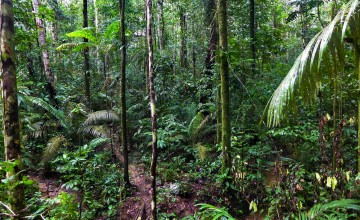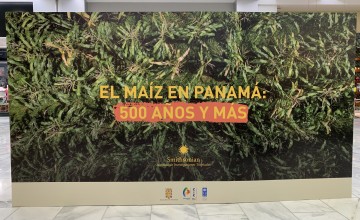
Dolores
Piperno
The data win in the end. A multidisciplinary approach to scientific questions and close collaboration with geneticists, plant physiologists and other scholars will piece together a reliable picture of the past.
Projects and Stories
Recent Publications
Lorant et al The Potential Role of Genetic Assimilation during Maize Domestication PLoS One 12 (9): e0184202.
Piperno, Dolores R. 2017. Assessing elements of an extended evolutionary synthesis for plant domestication and agricultural origin research. Proceedings of the National Academy of Sciences, 114 (25): 6429-6437.
Research Focus
My research interests have mainly involved the archaeology and human ecology of the lowland American tropics together with the biogeographical and climatological history of the tropical biome. They have included study of phytoliths, starch grains and pollen at archeological sites in Panama, Mexico, Ecuador, Peru, and Israel. A primary interest is the origins of agriculture worldwide and an associated current project involves the investigation of teosinte (wild maize) and maize growth and phenotypic (developmental) plasticity in the atmospheric CO2 and temperature conditions in which they were first collected by human populations and cultivated. Phenotypic plasticity, which may be directly induced by developmentally-mediated environmental cues and result in rapid phenotypic divergences in part through changes in gene expression, is a neglected concept in domestication research despite its increasing importance in evolutionary biology. This project will soon incorporate study of wild and domesticated beans (Phaseolus spp.) and squashes (Cucurbita spp.).
Another main focus of current investigation is the impact and legacies of prehistoric human modification on Amazonian forests through phytolith and charcoal studies of terrestrial soils from underneath standing interfluvial and riverine forests in remote areas of the Amazon Basin. This project will also involve large expansions of the Amazonian modern phytolith reference collection so that the numerous currently unknown phytoliths being retrieved from the ancient soils can be identified and employed to reconstruct prehistoric forest management of various types.
Contact
Research Overview
When and how did humans domesticate plants, and why did agriculture originate?
The development of agricultural societies made possible by plant and animal domestication was one of the most transformative events in human and ecological history. Independent beginnings of agriculture occurred between 12,000 and 10,000 years ago in a number of world regions, including the American tropics, southwest Asia, and China. Plant domestication was at its core an evolutionary process involving both natural and human selection for traits favorable for harvesting and consumption. Ever-improving analytic methods for retrieving empirical data from archaeological sites, together with advances in genetic, genomic, and experimental research on living crops and their wild ancestors are providing new understandings of, and mechanisms for domestication and early agriculture (see discussion under Research Focus). Scholars have long debated why hunters and gatherers became farmers, a question that will also see increasing understanding.
When, where, and how was the tropical forest exploited and modified by prehistoric cultures?
Prominent scholars once believed that the Neotropical forest vegetation and landscape were little altered by pre-Columbian cultures. It is now known that significant, sometimes profound, human environmental modification of many types (fire, vegetation clearing; depression of preferred prey through over-exploitation; construction of earthworks and roads) has a deep history in the American tropics. However, some regions remain understudied. Still not understood, for example, is when and how a human presence may have modified landscapes across the vast terra firme (interfluvial) forest zone of the Amazon Basin. Multi-proxy analyses of lake sediments and terrestrial soils (e.g., pollen, phytoliths, charcoal) are at once improving our resolution of both natural- and human-cased environmental change in Amazonia and elsewhere, and expanding the types of locations such evidence can be found in.
How can plant microfossils be improved as a discovery tool for paleobotanical history?
Plant microfossils such as phytoliths, starch grains, and pollen can be used to effectively study prehistoric plant exploitation and agriculture. In the Neotropics, many important crops such as maize, squashes, manioc, and yams can be identified. Archaeological materials offering robust contexts for microfossil study now include stone tools, ceramics, sediments, and human teeth. Future research should expand the number of identifiable taxa and refine current identifications, discover more about the types of plant preparation and consumption the microfossils can reveal (e.g., chicha-making?), and add to understanding of their roles in documenting prehistoric plant usage in the Neotropics and elsewhere.
Education
B.S. in Medical Technology, Rutgers University, 1971.
M.A. in Anthropology, Temple University, 1979.
Ph.D.in Anthropology, Temple University, 1983.
(Major advisor: Dr. Anthony Ranere.)
Selected Publications
Lorant A, Pederson, S., Holst, I., Hufford, M.B., Winter, K., Piperno, D.R., Ross-Ibarra, J. The potential role of genetic assimilation during maize domestication. PLoS One https://doi.org/10.1371/journal.pone.0184202.
Piperno, D.R., Ranere, A.J., Dickau, R., Aceituno, F. (2017) Niche construction and optimal foraging theory in Neotropical agricultural origins: A re-evaluation in consideration of the empirical Evidence. Journal of Archaeological Science 78:214-220.
Piperno, D.R., Holst, I., Winter, K., McMillan, O. 2014. Teosinte before domestication: Experimental study of growth and phenotypic variability in Late Pleistocene and early Holocene environments. Quaternary International, doi:10.1016/j.quaint.2013.12.049
Piperno, D.R. 2011. The Origins of Plant Cultivation and Domestication in the New World Tropics: Patterns, Process, and New Developments. In The Beginnings of Agriculture: New Data, New Ideas, edited by D. Price and O. Bar-Yosef. Special Issue of Current Anthropology. Vol 52, No. S4, 453-470.
Piperno, D.R., Ranere, A.J., Holst, I., Iriarte, J., & Dickau, R. 2009. Starch grain and phytolith evidence for early ninth millennium B.P. maize from the Central Balsas River Valley, Mexico. Proceedings of the National Academy of Sciences USA, 106:5019-5024.
Piperno, D.R. Phytoliths: A Comprehensive Guide for Archaeologists and Paleoecologists. 2006. AltaMira Press, Lanham MD.
Piperno, D.R., Ranere, A.J., Holst, I., & Hansell, P. 2000. Starch Grains Reveal Early Root Crop Horticulture in the Panamanian Tropical Forest. Nature, 407:894-897.
Piperno, D.R., & Pearsall, D.M. 1998. The Origins of Agriculture in the Lowland Neotropics. Academic Press, San Diego.


